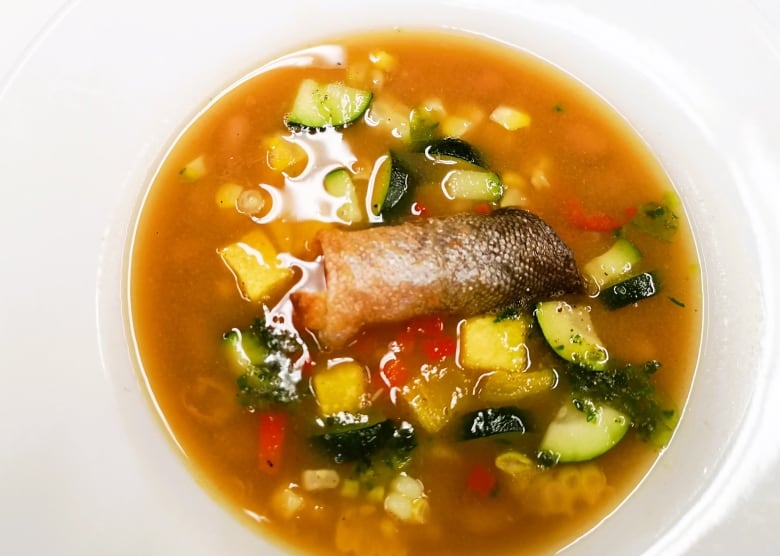Top Toques' Chef's Table dinner highlights Indigenous ingredients, techniques: Andrew Coppolino
Chef Destiny Moser blends traditional Indigenous food with French and North American favourites

This week, in a collaboration with Kitchener's Top Toques culinary school, chef Destiny Moser served a five-course dinner using two dozen ingredients that spanned cultures and also served as an instructional medium for teaching Indigenous foods and cooking.
"We created a menu focusing on Indigenous ingredients, but we wanted to make sure we weren't too far from the recipes and dishes we're familiar with," said Moser.
That included bannock, an ostensibly Indigenous flat bread which was traditionally cooked on hot stones.
A graduate of Top Toques and Status First Nation as part of the Ojibwe tribe of the Rainy River Band, Moser says bannock is familiar to many people, but it "weighs in" significantly on Truth and Reconciliation as a dish that many assume is Indigenous.
"It's an educational opportunity. I like to point out that bannock is actually Scottish," she said.

Rather, Indigenous people were forced to learn how to make it by the settlers when they were forced off the land and lost access to their traditional food sources.
Top Toques chef-instructors Dean Michielsen, Darryl Howie and Elaina Kourie and teams of students worked over two days to prepare bannock and the other elements of the dinner.
The menu featured iconic, and delicious, Three Sisters soup with its trio of corn, beans and squash, which traditionally are grown together. Corn stalks provide structure for the beans to climb, while mature squash leaves shelter the root area impeding weed growth and moderating temperature. The beans nourish the soil with nitrogen.
Moser, whose mother was born as part of the Rainy River tribe and was also a part of the Sixties Scoop, has used Indigenous food and cooking to highlight and advocate for Indigenous culture in Waterloo Region when she visits area high schools.
Her duck confit main course blended French technique with a 36-hour sous vide that Moser and the kitchen employed to replicate the long braise that early Indigenous cooks would have used.

She noted that the sous vide and the extra confit fat would not have been used by early Indigenous cooks, but rather a long, slow cook over fire which produced similar results to the Gascony, France dish. The resulting duck was very tender and rich.
Also on the menu was seasonal smoked Arctic char, pumpkin, sage, wheat berries, cranberries and verjus (an ancient ingredient made from the juice of unripened grapes).
Wild rice, "manoomin" in Anishinaabe, is a sacred ingredient for Indigenous cultures, and one that has a special place in this country. Moser said that of four wild rice species – actually an aquatic grass – three are native to Canada and is its only native grain. Corn, while plentiful here, was originally domesticated by the Indigenous peoples of southern Mexico.
Once ubiquitous around the Great Lakes, wild rice lends its name to Rice Lake in the Trent-Severn Waterway and other geographical features given the plentiful plants that once grew there.
But like many species, its habitat has been significantly reduced making it scarce and under threat for survival. Wild rice thrives in a climate with harsh winters, but researchers wonder if climate change and more moderate winters could affect where it can grow sustainably.

Moser noted the nutty quality of grains and how the students she prepares it for love the wild rice and pumpkin salad made with sunflower oil, rather than olive oil.
"I make this dish for students I teach about Indigenous cooking, and they love it. And probably because it has a sweetness."
Last year, Moser visited Waterloo Region District School Board high schools with the Ontario Youth Apprenticeship Program team to do hands-on cooking workshops about Indigenous food and her own personal path to becoming a chef.
Having been active in the community demonstrating and speaking on behalf of Indigenous cooking for several years now, Moser said she has seen advancements in people's understanding of Indigenous foodways, both locally and internationally.
She attended the sixth annual conference on Native American Nutrition in Minnesota earlier this month. The theme was Resurgence of Indigenous Foodways, and she said she learned how diet – and particularly Indigenous diets – impact health.

She pointed out that before settlers, Indigenous people did not have diabetes, but since being introduced to flour, sugar and other processed foods, the Indigenous population of Canada is the largest population with the disease.
"At the conference, they noted similar patterns with other Indigenous communities around the world. Scientists, doctors and nutritionists are finding that a lot of these diseases that we have now like diabetes, heart disease and cancers are driven in part by the food we put in our diet. We have a lot of processed food, and it's also how we're farming," Moser said.
Her goal has been to advocate for a return to traditional Indigenous ingredients, cooking and foodways.
Moser said she sees growth in understanding closer to home, too, including more Indigenous foods being grown in community gardens and more attention paid to the topic at her alma mater, Top Toques, from which she graduated a few years ago.
"At that time, when we got to world cuisines, at no point did we talk about Indigenous food. I'm very prideful that now the school constantly keeps me involved and figuring out how we can incorporate Indigenous cuisine in teaching as they move forward with new students."

